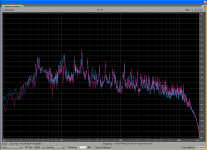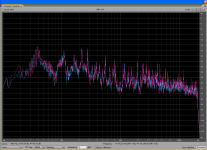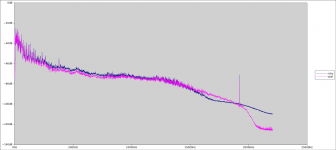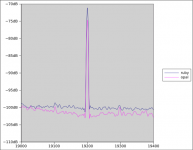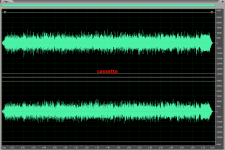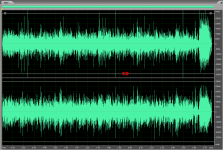Why do you doubt whatever it is you doubt?
I agree with your last sentence.
Sceptical. It's a state of mind. You don't want it to change. Changing it is like accepting defeat.
If you are capable of "seeing" the truth, you don't have to wait till you know who the "messenger" is.
Last edited:
Yes please. Use a high quality battery powered tape player if possible with clean heads and make sure it's standing on something non conducting.
OK, try this
foot_tapper.zip - FileFactory
and tell me if it is worth spending time with level matching etc.
iko, I have such files. Original cassette A/D recorded vs. CD file. Eric Clapton. Anyone interested?
Yes, please. I think it's nice for us to do such tests, and it's important to be honest about our impressions.
Edit: I see you already posted it. Thanks!
I made the comment above about analog signals on the Internet in jest, but it occurs to me that any analog waveform can be represented in continuous form by some equation. Admittedly it might take a hundred page equation to describe 3 seconds of music, but in theory it can be done. So there is a way to "send" analog signals digitally without digitization. Unfortunately I don't have any device to play them back. Old analog computers didn't come with sound cards. This whole thing is a PITA; it might be better to just scratch the darn waveform onto a rotating plastic cylinder.😱
OK, try this
foot_tapper.zip - FileFactory
and tell me if it is worth spending time with level matching etc.
Despite having read 1984, I really am currently resident in China so will have to get back to this when I have some time tomorrow.
Sceptical. It's a state of mind. You don't want it to change. Changing it is like accepting defeat.
If you are capable of "seeing" the truth, you don't have to wait till you know who the "messenger" is.
For me skepticism is healthy. Otherwise one can end up accepting all kind of irrational woo.
OK, try this
foot_tapper.zip - FileFactory
and tell me if it is worth spending time with level matching etc.
Here is the spectrum 😉.
I recorded that file years ago from SONY tape deck.
Attachments
Damn, you guys move to fast. I didn't have a chance to listen to the "jewels". That would have been a fun test. (Busy time of the year for me, not much time for fun)
Oh, and the for the other tests - at least some of us actually used proper protocol. The ABX comparator in Foobar. So a part of the results is valid.
Oh, and the for the other tests - at least some of us actually used proper protocol. The ABX comparator in Foobar. So a part of the results is valid.
I made the comment above about analog signals on the Internet in jest, but it occurs to me that any analog waveform can be represented in continuous form by some equation. Admittedly it might take a hundred page equation to describe 3 seconds of music, but in theory it can be done. So there is a way to "send" analog signals digitally without digitization. Unfortunately I don't have any device to play them back. Old analog computers didn't come with sound cards. This whole thing is a PITA; it might be better to just scratch the darn waveform onto a rotating plastic cylinder.😱
The complex FFT represents the music as an equation - sum of sine waves - but the coefficients for amplitude and phase of the different frequency components still need to be quantized and represented digitally.
You could do some kind of approximation by resynthesizing the music from models of the instruments but the timing of the notes would again require quantization.
If the music is electronic anyway then it could be done since the original would be quantized and the models would be perfect since they would be the original instruments.
So you can play your midi files and be happy if you like but quickly you'll realize that the new problem is that when the equations are converted to analogue form for you to hear there is some error and they are no longer perfect...
For me skepticism is healthy. Otherwise one can end up accepting all kind of irrational woo.
Whatever Blind test result wouldn't change that irrationality, unless you are the one who suddenly can hear the differences. People are making assumptions and believe that the assumption is truth, including all opamps sound the same.
If blind test show that opamps don't sound the same, more people will think they don't. And more people think they dont sound the same, more people assume they don't. Most are just followers. You need to be convincing to be followed. Now, which one is more convincing or rational, that I can hear the superiority of blue to green, or that your gowd exists?
It's amazing how much spin these tests bring out. Just listen and vote. Give you opinions before the results. All else is spin, back tracking, butt covering and rationalizing. Full Stop.
For me, this test was dominated by the awful noise. I think I might not have even got as far as listening to one of the samples all the way through because I found it so unlistenable.
I could hear the difference between the tracks immediately and reliably at the first vocal.
I think the most interesting point for me is that the spectrums could have been constructed intentionally to test the theory of high frequency ground loop noise from the previous blue green test. This time with the defects in the blue green test magnified to the point of being audible to all.
In this case, Ruby is a model for blue and Opal a model for green.
Ruby has high frequency noise spike about double the amplitude of Opal and Opal has a low pass filter response which cuts out the very high frequencies.
My listening experience was that Ruby had more detail but was rougher and Opal was smoother but had less detail.
There is a corresponding impression posted by one listener earlier in the thread and these impressions and the preferences expressed in the vote correspond to the impressions for the blue green test and the voting preference in the blue green test where the noise artifacts were assumed to be 90dB -100dB lower.
Spectrums show attenuated high frequency of Opal and detail shows relative amplitudes of noise spike in both cases.
So, I'm proposing that even if the HF noise seems to be inaudible, it affects your perception of the smoothness of the sound with higher HF noise corresponding to a less smooth sound.
I could hear the difference between the tracks immediately and reliably at the first vocal.
I think the most interesting point for me is that the spectrums could have been constructed intentionally to test the theory of high frequency ground loop noise from the previous blue green test. This time with the defects in the blue green test magnified to the point of being audible to all.
In this case, Ruby is a model for blue and Opal a model for green.
Ruby has high frequency noise spike about double the amplitude of Opal and Opal has a low pass filter response which cuts out the very high frequencies.
My listening experience was that Ruby had more detail but was rougher and Opal was smoother but had less detail.
There is a corresponding impression posted by one listener earlier in the thread and these impressions and the preferences expressed in the vote correspond to the impressions for the blue green test and the voting preference in the blue green test where the noise artifacts were assumed to be 90dB -100dB lower.
Spectrums show attenuated high frequency of Opal and detail shows relative amplitudes of noise spike in both cases.
So, I'm proposing that even if the HF noise seems to be inaudible, it affects your perception of the smoothness of the sound with higher HF noise corresponding to a less smooth sound.
Attachments
To me, your explanation is overcomplicated and not shooting on the target.
1st, Mooly was definitely not aware of the presence of the -78dB, 19kHz intereference line. This one is, nevertheless, inaudible.
2nd, comparison of ruby vs. opal test with my blue vs. green is misleading. Anyway, green does not content increased amount of HF noise.
Have you tried my cassette sound record I posted yesterday? Or at least checked the spectrum from CD and cassette that I posted?
The reason why ruby and opal sounded different is very simple. The ruby file has constant and very high level of tape hiss (even plenty of low frequency hiss!) and is horribly distorted. Both hiss and distortion affect perception of mids and highs. Last, but not least, all cassette records have decay of REAL high frequency content. That means sound components, not hiss. You can see it well in my spectra from CD and cassette. And please note that frequency components at Clapton CD file, in 15 - 20kHz range, are much higher (even compared with amplitude of mids) than Mooly's 19 kHz isolated line. And the highs are REAL sound. The cassette (Clapton) that has much less energy above 10kHz sounds smoothed and muffled.
Your analysis is nice, we may have a lot of fun, but is completely misleading.
1st, Mooly was definitely not aware of the presence of the -78dB, 19kHz intereference line. This one is, nevertheless, inaudible.
2nd, comparison of ruby vs. opal test with my blue vs. green is misleading. Anyway, green does not content increased amount of HF noise.
Have you tried my cassette sound record I posted yesterday? Or at least checked the spectrum from CD and cassette that I posted?
The reason why ruby and opal sounded different is very simple. The ruby file has constant and very high level of tape hiss (even plenty of low frequency hiss!) and is horribly distorted. Both hiss and distortion affect perception of mids and highs. Last, but not least, all cassette records have decay of REAL high frequency content. That means sound components, not hiss. You can see it well in my spectra from CD and cassette. And please note that frequency components at Clapton CD file, in 15 - 20kHz range, are much higher (even compared with amplitude of mids) than Mooly's 19 kHz isolated line. And the highs are REAL sound. The cassette (Clapton) that has much less energy above 10kHz sounds smoothed and muffled.
Your analysis is nice, we may have a lot of fun, but is completely misleading.
Last edited:
To me, your explanation is overcomplicated and not shooting on the target.
1st, Mooly was definitely not aware of the presence of the -78dB, 19kHz intereference line. This one is, nevertheless, inaudible.
2nd, comparison of ruby vs. opal test with my blue vs. green is misleading. Anyway, green does not content increased amount of HF noise.
Have you tried my cassette sound record I posted yesterday? Or at least checked the spectrum from CD and cassette that I posted?
The reason why ruby and opal sounded different is very simple. The ruby file has constant and very high level of tape hiss (even plenty of low frequency hiss!) and is horribly distorted. Both hiss and distortion affect perception of mids and highs. Last, but not least, all cassette records have decay of REAL high frequency content. That means sound components, not hiss. You can see it well in my spectra from CD and cassette. And please note that frequency components at Clapton CD file, in 15 - 20kHz range, are much higher (even compared with amplitude of mids) than Mooly's 19 kHz isolated line. And the highs are REAL sound. The cassette (Clapton) that has much less energy above 10kHz sounds smoothed and muffled.
Your analysis is nice, we may have a lot of fun, but is completely misleading.
I said opal could be a model of green with lower HF noise and smoother sound.
In the case of the tape, you say noise had been added to Ruby and I think we have established that there was a ground loop that added noise to blue.
I think there are parallels.
I'm pretty sure the 19kHz signal is why I find the files so unpleasant. The other distortion and noise just makes them sound like a poor quality recording.
I will try your Clapton recording.
Whatever Blind test result wouldn't change that irrationality, unless you are the one who suddenly can hear the differences. People are making assumptions and believe that the assumption is truth, including all opamps sound the same.
If blind test show that opamps don't sound the same, more people will think they don't. And more people think they dont sound the same, more people assume they don't. Most are just followers. You need to be convincing to be followed. Now, which one is more convincing or rational, that I can hear the superiority of blue to green, or that your gowd exists?
I don't think anyone has expressed the opinion that all op amps sound the same.
I think a problem was discovered in the fruity op amp test which changed the sound more significantly than the differences between the op amps though so I don't think the test samples were a fair representation of the op amp sound.
Clapton on cassette and CD, time domain (frequency domain comparison on previous page).
cassette:
1) constant hiss and noise
2) high frequency signal roll-off
3) higher distortion
4) lower dynamic range (not valid in case of loudness war new age CD files and re-masters)
So this is a preference for cassette.
DR (dynamic range) on cassette, for this Clapton file = 12. DR on CD = 15.
cassette:
1) constant hiss and noise
2) high frequency signal roll-off
3) higher distortion
4) lower dynamic range (not valid in case of loudness war new age CD files and re-masters)
So this is a preference for cassette.
DR (dynamic range) on cassette, for this Clapton file = 12. DR on CD = 15.
Attachments
- Status
- Not open for further replies.
- Home
- General Interest
- Everything Else
- Based on sonics... which do you prefer ?
